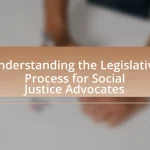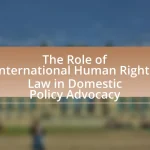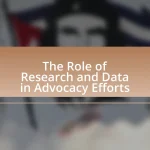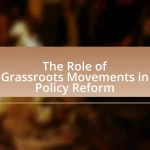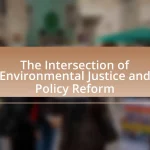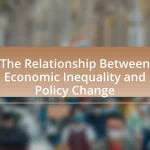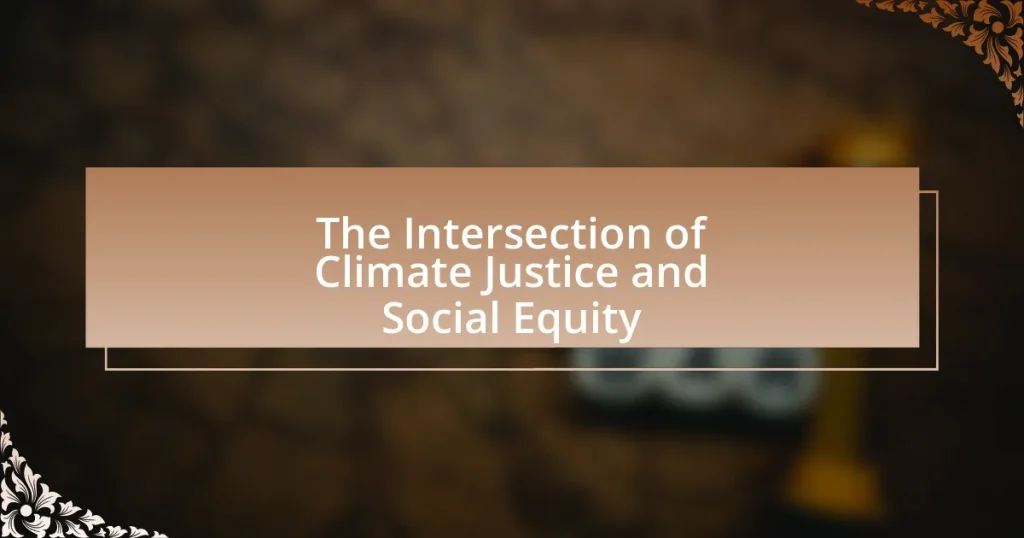The article explores the intersection of climate justice and social equity, highlighting how marginalized communities disproportionately suffer from the impacts of climate change and environmental degradation. It emphasizes the need for integrating social equity into climate policies to address systemic inequalities, as low-income and minority populations are often more vulnerable to climate-related disasters. The historical context of these concepts is examined, along with the implications for marginalized communities, the role of grassroots movements, and the importance of international agreements in promoting equitable climate action. Key principles of climate justice, such as equity, participation, and accountability, are discussed, along with best practices for ensuring that vulnerable populations are prioritized in climate initiatives.
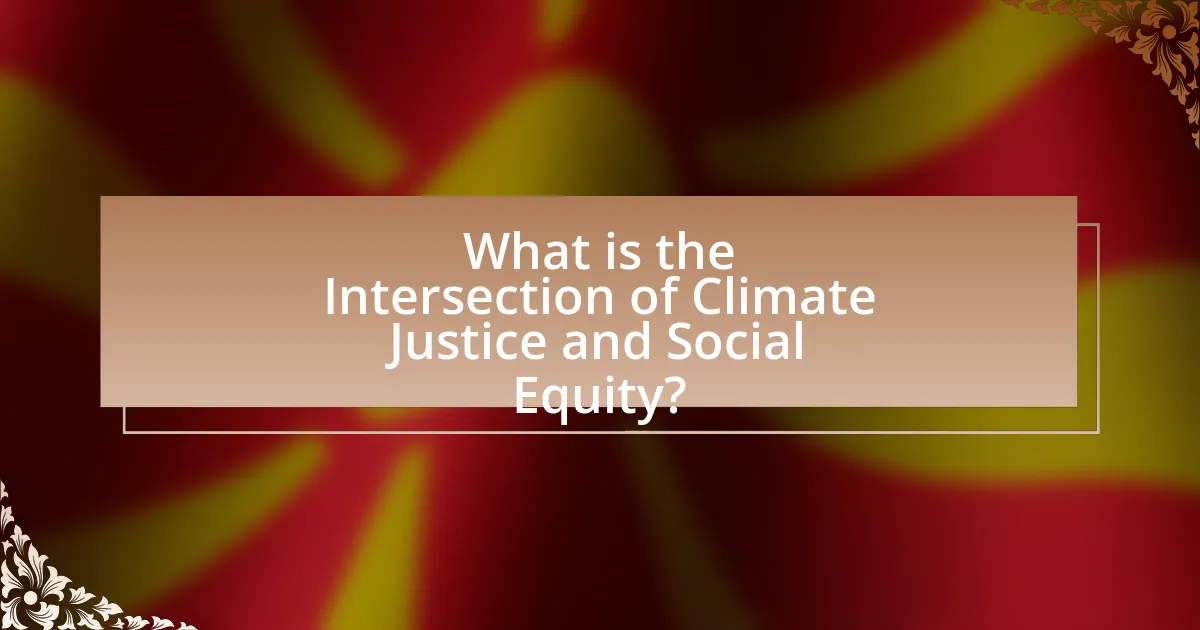
What is the Intersection of Climate Justice and Social Equity?
The intersection of climate justice and social equity refers to the recognition that marginalized communities disproportionately experience the impacts of climate change and environmental degradation. Climate justice advocates for the fair distribution of environmental benefits and burdens, emphasizing that social equity must be integrated into climate policies to address systemic inequalities. For instance, studies show that low-income and minority populations are more likely to live in areas vulnerable to climate-related disasters, such as flooding and heatwaves, highlighting the need for inclusive decision-making processes that prioritize these communities.
How do climate justice and social equity relate to each other?
Climate justice and social equity are interconnected concepts that address the disproportionate impacts of climate change on marginalized communities. Climate justice emphasizes the need for fair treatment and involvement of all people in environmental policies, recognizing that low-income and minority groups often bear the brunt of climate-related disasters. Social equity focuses on ensuring that all individuals have access to the same opportunities and resources, which includes addressing systemic inequalities that exacerbate vulnerability to climate change. Research indicates that communities of color and low-income populations are more likely to experience adverse effects from climate change, such as increased flooding and heatwaves, due to historical injustices and lack of resources. Therefore, achieving climate justice requires integrating social equity principles to ensure that vulnerable populations are prioritized in climate action and policy-making.
What are the historical contexts of climate justice and social equity?
The historical contexts of climate justice and social equity are rooted in the recognition that marginalized communities disproportionately experience the impacts of climate change. This understanding emerged in the late 20th century, particularly during the 1991 First National People of Color Environmental Leadership Summit, which highlighted the environmental injustices faced by communities of color. The concept of climate justice evolved from environmental justice, emphasizing the need for equitable distribution of environmental benefits and burdens.
Key events, such as the 1992 Earth Summit in Rio de Janeiro, further solidified the connection between social equity and environmental policies, advocating for the inclusion of vulnerable populations in decision-making processes. The Intergovernmental Panel on Climate Change (IPCC) reports have consistently shown that low-income and marginalized groups are more vulnerable to climate impacts, reinforcing the necessity for integrating social equity into climate action strategies.
How do systemic inequalities impact climate change responses?
Systemic inequalities significantly hinder effective climate change responses by disproportionately affecting marginalized communities. These communities often lack the resources, political power, and access to information necessary to engage in climate action or adapt to climate impacts. For instance, a report by the Intergovernmental Panel on Climate Change (IPCC) highlights that low-income populations are more vulnerable to climate-related disasters due to inadequate infrastructure and limited financial means for recovery. Furthermore, systemic barriers such as racial discrimination and economic disparities exacerbate the challenges faced by these groups, leading to unequal participation in decision-making processes related to climate policies. This inequity results in climate solutions that do not address the needs of the most affected populations, ultimately undermining the overall effectiveness of climate change mitigation and adaptation efforts.
Why is the intersection of climate justice and social equity important?
The intersection of climate justice and social equity is important because it addresses the disproportionate impacts of climate change on marginalized communities. These communities often face greater environmental hazards and have fewer resources to adapt to climate-related challenges, leading to increased vulnerability. For instance, a report by the United Nations highlights that low-income populations are more likely to suffer from extreme weather events, which exacerbates existing social inequalities. By integrating social equity into climate justice initiatives, policies can be designed to ensure that all communities have equitable access to resources, decision-making processes, and opportunities for resilience, ultimately fostering a more just and sustainable future.
What are the implications for marginalized communities?
Marginalized communities face significant implications from climate change, including increased vulnerability to environmental hazards and limited access to resources for adaptation. These communities often reside in areas more susceptible to climate impacts, such as flooding and extreme heat, which exacerbates existing social and economic inequalities. For instance, a report by the National Oceanic and Atmospheric Administration indicates that low-income neighborhoods are disproportionately affected by heatwaves, leading to higher health risks. Additionally, marginalized groups frequently lack the political power to influence climate policies, resulting in their needs being overlooked in decision-making processes. This systemic exclusion further entrenches their vulnerability and hinders their ability to recover from climate-related events.
How does climate change exacerbate existing social inequities?
Climate change exacerbates existing social inequities by disproportionately affecting marginalized communities who often lack the resources to adapt or recover from climate-related disasters. For instance, low-income neighborhoods frequently experience higher exposure to environmental hazards, such as flooding and heatwaves, due to inadequate infrastructure and limited access to emergency services. According to a report by the National Oceanic and Atmospheric Administration, communities of color are more likely to live in areas vulnerable to climate impacts, which can lead to increased health risks and economic instability. This systemic disadvantage is compounded by factors such as limited political power and access to information, further entrenching social inequities in the face of climate change.

What are the key principles of Climate Justice?
The key principles of Climate Justice include equity, participation, and accountability. Equity emphasizes that those who have contributed least to climate change, often marginalized communities, should not bear the brunt of its impacts. Participation ensures that all stakeholders, particularly vulnerable populations, have a voice in decision-making processes related to climate policies. Accountability mandates that governments and corporations are held responsible for their actions and their contributions to climate change. These principles are supported by the recognition that climate change disproportionately affects low-income and marginalized communities, as highlighted in reports from organizations like the Intergovernmental Panel on Climate Change (IPCC), which detail the social and economic disparities exacerbated by climate impacts.
How does climate justice advocate for vulnerable populations?
Climate justice advocates for vulnerable populations by addressing the disproportionate impacts of climate change on marginalized communities. This advocacy emphasizes the need for equitable distribution of resources, decision-making power, and climate adaptation strategies that prioritize the needs of those most affected. For instance, studies show that low-income communities and communities of color are more likely to experience severe weather events and environmental hazards, highlighting the necessity for targeted policies that protect these groups. By promoting inclusive policies and ensuring that vulnerable populations have a voice in climate action, climate justice seeks to rectify historical injustices and create a more equitable future.
What role do indigenous rights play in climate justice?
Indigenous rights are crucial in climate justice as they recognize the sovereignty and land stewardship of Indigenous peoples, who are often the most affected by climate change. These rights empower Indigenous communities to protect their ancestral lands and resources, which are vital for biodiversity and climate resilience. For instance, the United Nations Declaration on the Rights of Indigenous Peoples emphasizes the importance of Indigenous participation in decision-making processes related to environmental governance. Studies show that Indigenous-managed lands often have lower deforestation rates and higher biodiversity, highlighting their effective stewardship. Therefore, integrating Indigenous rights into climate justice frameworks not only supports social equity but also enhances environmental sustainability.
How does climate justice address economic disparities?
Climate justice addresses economic disparities by advocating for equitable distribution of resources and opportunities in the context of climate change. It emphasizes that marginalized communities, often the most affected by environmental degradation, should receive support and resources to adapt and thrive. For instance, studies show that low-income populations are disproportionately impacted by climate-related disasters, which can exacerbate existing economic inequalities. By promoting policies that prioritize these vulnerable groups, climate justice seeks to rectify systemic inequities, ensuring that all communities have access to clean energy, sustainable jobs, and resilience-building initiatives. This approach not only addresses immediate economic disparities but also fosters long-term social equity in the face of climate challenges.
What strategies are used to promote climate justice?
Strategies used to promote climate justice include advocacy for equitable policy-making, community engagement, and the integration of indigenous knowledge. Advocacy for equitable policy-making ensures that marginalized communities have a voice in climate-related decisions, as seen in the Paris Agreement, which emphasizes the importance of inclusivity. Community engagement involves grassroots movements that mobilize local populations to demand accountability from governments and corporations, exemplified by initiatives like the Sunrise Movement in the United States. Additionally, integrating indigenous knowledge into climate strategies recognizes the value of traditional ecological practices, which can enhance resilience and sustainability, as highlighted by various studies on indigenous land management practices.
How can grassroots movements influence climate policy?
Grassroots movements can influence climate policy by mobilizing community engagement and advocating for local and national changes. These movements often raise awareness about climate issues, leading to increased public pressure on policymakers. For example, the Sunrise Movement successfully pushed for the Green New Deal in the United States, demonstrating how organized activism can shape legislative agendas. Additionally, grassroots organizations often highlight the voices of marginalized communities disproportionately affected by climate change, ensuring that equity is a central component of climate policy discussions. This approach not only fosters inclusive dialogue but also drives systemic change by aligning climate action with social justice principles.
What are the roles of international agreements in climate justice?
International agreements play a crucial role in climate justice by establishing frameworks for cooperation among nations to address climate change impacts equitably. These agreements, such as the Paris Agreement, set binding targets for greenhouse gas emissions reductions, ensuring that developed countries take responsibility for their historical contributions to climate change while supporting developing nations in their adaptation and mitigation efforts. For instance, the Paris Agreement aims to limit global warming to well below 2 degrees Celsius, which directly impacts vulnerable populations disproportionately affected by climate change. Furthermore, international agreements facilitate financial mechanisms, like the Green Climate Fund, which allocates resources to support climate resilience in marginalized communities, thereby promoting social equity.

How does Social Equity manifest in climate policies?
Social equity manifests in climate policies through the inclusion of marginalized communities in decision-making processes and the equitable distribution of resources and benefits. This approach ensures that vulnerable populations, often disproportionately affected by climate change, receive support and protection. For instance, policies like the Green New Deal in the United States emphasize job creation in disadvantaged areas, aiming to address both environmental and social injustices. Additionally, research from the United Nations highlights that integrating social equity into climate strategies can lead to more effective and sustainable outcomes, as it fosters community resilience and participation.
What are the indicators of social equity in climate action?
Indicators of social equity in climate action include access to resources, representation in decision-making, and equitable distribution of benefits and burdens. Access to resources refers to the availability of financial, technical, and informational support for marginalized communities to engage in climate initiatives. Representation in decision-making ensures that diverse voices, particularly from historically underrepresented groups, influence climate policies. Equitable distribution of benefits and burdens assesses whether the advantages of climate action, such as job creation and improved health outcomes, are shared fairly among all communities, particularly those most affected by climate change. These indicators are essential for evaluating the effectiveness of climate policies in promoting social equity.
How can equitable access to resources be ensured?
Equitable access to resources can be ensured through the implementation of inclusive policies that prioritize marginalized communities. These policies should focus on addressing systemic inequalities by providing targeted support, such as financial assistance, education, and infrastructure development, specifically designed for underrepresented groups. For instance, the United Nations’ Sustainable Development Goals emphasize the importance of reducing inequalities and ensuring access to essential services for all, highlighting that equitable resource distribution is crucial for achieving social equity and climate justice.
What measures can be taken to involve communities in decision-making?
To involve communities in decision-making, implementing participatory governance measures is essential. These measures include establishing community advisory boards, conducting public consultations, and utilizing participatory budgeting processes. For instance, cities like Porto Alegre in Brazil have successfully employed participatory budgeting, allowing residents to directly influence budget allocations, which has led to increased civic engagement and satisfaction with local governance. Additionally, research from the International Institute for Environment and Development highlights that involving marginalized communities in environmental decision-making leads to more equitable outcomes and better resource management.
What challenges exist in achieving social equity in climate initiatives?
Achieving social equity in climate initiatives faces several challenges, primarily including systemic inequalities, lack of representation, and inadequate funding. Systemic inequalities, such as those based on race, income, and geography, often result in marginalized communities bearing the brunt of climate impacts while having limited access to resources for adaptation and mitigation. Lack of representation in decision-making processes further exacerbates these issues, as the voices of affected communities are frequently overlooked, leading to policies that do not address their specific needs. Additionally, inadequate funding for climate initiatives targeting social equity limits the ability to implement effective programs that could alleviate disparities. For instance, a report by the United Nations highlights that low-income communities are disproportionately affected by climate change, yet they receive a fraction of the funding allocated for climate resilience projects.
How do political and economic barriers hinder progress?
Political and economic barriers hinder progress by creating obstacles that limit access to resources, decision-making power, and equitable opportunities. For instance, political instability can lead to inconsistent policies that disrupt investment in sustainable practices, while economic inequality restricts marginalized communities from participating in climate action initiatives. According to the United Nations Development Programme, countries with high levels of corruption and poor governance often experience slower economic growth and reduced capacity to address climate change effectively. This correlation illustrates how political and economic factors directly impede efforts toward achieving climate justice and social equity.
What are the consequences of neglecting social equity in climate strategies?
Neglecting social equity in climate strategies leads to exacerbated inequalities and increased vulnerability among marginalized communities. When climate policies fail to consider the needs of these groups, they often face disproportionate impacts from climate change, such as extreme weather events and resource scarcity. For instance, a report by the United Nations highlights that low-income populations are more likely to suffer from heatwaves and flooding, as they typically reside in less resilient areas. Additionally, neglecting social equity can result in social unrest and resistance to climate initiatives, as affected communities may feel excluded from decision-making processes. This exclusion undermines the effectiveness of climate strategies, as inclusive approaches are essential for fostering community support and ensuring equitable resource distribution.
What are best practices for integrating climate justice and social equity?
Best practices for integrating climate justice and social equity include engaging marginalized communities in decision-making processes, ensuring equitable access to resources, and implementing policies that address systemic inequalities. Engaging marginalized communities allows for the incorporation of diverse perspectives and needs, which is essential for effective climate action. For instance, the United Nations emphasizes the importance of participatory governance in achieving sustainable development goals, highlighting that inclusive processes lead to better outcomes. Additionally, equitable access to resources, such as clean energy and green spaces, can mitigate the disproportionate impacts of climate change on vulnerable populations. Research from the Climate Justice Alliance shows that policies addressing systemic inequalities, like the Green New Deal, can create jobs and improve living conditions while reducing emissions. These practices collectively foster resilience and promote social equity in the face of climate challenges.
How can organizations effectively collaborate with affected communities?
Organizations can effectively collaborate with affected communities by actively engaging them in decision-making processes and ensuring their voices are heard. This involves establishing transparent communication channels, conducting regular consultations, and incorporating community feedback into project planning and implementation. For instance, the Community-Based Participatory Research model has shown that when communities are involved in research and policy-making, outcomes are more relevant and beneficial to their needs, as evidenced by studies published in the American Journal of Public Health. Additionally, organizations should prioritize building trust through consistent and respectful interactions, which fosters a sense of ownership and empowerment among community members.
What frameworks can guide equitable climate action?
Equitable climate action can be guided by frameworks such as the Just Transition framework, the Climate Justice framework, and the Sustainable Development Goals (SDGs). The Just Transition framework emphasizes the need for a fair shift to a low-carbon economy that prioritizes the rights and livelihoods of workers and communities affected by climate change. The Climate Justice framework focuses on addressing the disproportionate impacts of climate change on marginalized communities, advocating for their inclusion in decision-making processes. The SDGs provide a comprehensive approach to sustainable development, ensuring that climate action aligns with social equity goals, such as poverty alleviation and gender equality. These frameworks collectively promote an inclusive approach to climate action, ensuring that vulnerable populations are prioritized and supported in the transition to a sustainable future.
